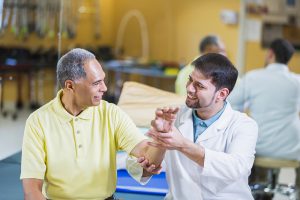Treating a Lifetime of Elbow Problems
 The elbow is a particularly complex joint for orthopaedic surgeons to treat. Unlike other joints, the elbow is fragile, unconstrained by surrounding bones, and heavily dependent on surrounding soft tissues for range of motion. Duke is home to a team of specialists dedicated to studying the elbow, publishing the latest research, and applying novel treatments for managing the myriad conditions that can occur at every stage of life.
The elbow is a particularly complex joint for orthopaedic surgeons to treat. Unlike other joints, the elbow is fragile, unconstrained by surrounding bones, and heavily dependent on surrounding soft tissues for range of motion. Duke is home to a team of specialists dedicated to studying the elbow, publishing the latest research, and applying novel treatments for managing the myriad conditions that can occur at every stage of life.
"Every day, all we do is treat elbows, wrists, and hands," says David Ruch, MD, a Duke orthopaedic surgeon and the chief of hand surgery in the Division of Hand & Upper Extremity, part of the Duke Orthopaedic Surgery Division. In most types of elbow surgery, the surgeon is reattaching torn ligaments to the bone rather than the traditional orthopaedic approach of fixing the bone. "Elbow surgeons must be focused on the bone as well as the soft tissue surrounding it, and that's what makes specializing in elbows particularly challenging," he says. "The elbow is probably the most difficult joint in the human body for which to restore motion."
Duke is one of the only centers in the Southeast where all elbow conditions are managed by one highly experienced team of fellowship-trained elbow specialists, many of whom have trained other surgeons around the country. "In many centers, different members of the orthopaedic team will take care of different conditions. Here, all of the providers take care of all of the conditions," says Ruch.
Adolescence and Young Adulthood
Repetitive stress from overhead or throwing sports accounts for many conditions in adolescents and young adults, particularly damage to the ligaments in the elbow. One of the frequently performed procedures for this condition is ulnar collateral ligament reconstruction, also known as "Tommy John surgery," named after the former major league baseball pitcher who had the first successful surgery in 1974. Several Duke studies are now underway to explore novel approaches for improving the procedure and returning patients to their activities more quickly.
Middle Age
As individuals reach middle age, degenerative tendon injuries around the elbow are becoming increasingly common, particularly lateral epicondylitis, or "tennis elbow." Medial epicondylitis, or "golfer's elbow," is another common problem. "We actually don't see this with golfers very often—not with good golfers anyway," Ruch jokes. "We find that it's more commonly associated with individuals who start lifting weights after not doing it for a while; they tear the tendon on the inside of their elbow." Surgical treatments for these conditions involve removing diseased muscle and reattaching healthy muscle back to the bone.
Later Life
In the later years of life, degenerative arthritis, stiffness, and inflammation lead many individuals to seek treatment from an elbow specialist. "We frequently see older men with large bone spurs that are preventing elbow mobility, simply as a result of chronic hard work," says Ruch. "We also treat many patients who have a loss of cartilage from inflammation, and that's leading us to work on finding a good replacement for cartilage." Duke surgeons are already transplanting grafts of healthy cartilage into damaged areas to relieve pain and restore range of motion.
To help patients in all stages of life, Duke orthopaedic surgeons are at the forefront of exploring and successfully applying new techniques for elbow treatment. One technique is free flap functional muscle transfer to restore elbow flexion in patients with functional muscle loss secondary to brachial plexus injuries, ischemic muscle loss, traumatic injuries, oncologic resections, or congenital absences. In an August 2016 study coauthored by Ruch, superior surgical results were reported with this reconstructive repair method.
Another promising therapy is regenerative medicine to stimulate healing and help patients avoid surgery. In one of the regenerative procedures, platelet-rich plasma (PRP) is collected from a patient's own blood and injected directly into the damaged area during an outpatient visit. Although PRP therapy is new and clinical research is continuing, it is showing promise for stimulating healing, reducing pain, and restoring function after a single injection followed by a course of physical therapy.